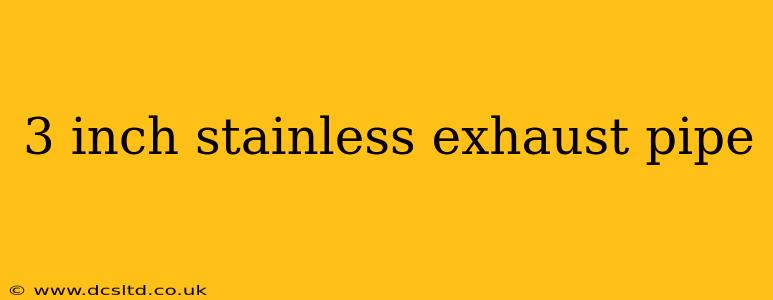Choosing the right exhaust pipe is crucial for performance, sound, and longevity. A 3-inch stainless steel exhaust pipe is a popular choice for many vehicle modifications, offering a balance of performance gains and durability. This guide dives deep into everything you need to know about 3-inch stainless steel exhaust pipes, answering common questions and helping you make an informed decision.
What are the benefits of a 3-inch stainless steel exhaust pipe?
A 3-inch stainless steel exhaust system offers several key advantages over smaller diameter or different material exhausts. The larger diameter (3 inches) allows for less exhaust restriction, improving engine breathing and potentially boosting horsepower and torque. Stainless steel is highly resistant to corrosion and rust, resulting in a longer lifespan compared to other materials like aluminized steel. This durability translates to less maintenance and a longer-lasting investment.
How much horsepower does a 3-inch exhaust add?
The horsepower gain from a 3-inch exhaust system varies greatly depending on several factors. These factors include the engine's specifications, the rest of the exhaust system (including the muffler and catalytic converter), the vehicle's overall tuning, and even the air intake system. While some claim significant gains, a more realistic expectation is a modest increase in horsepower and torque, often in the range of 5-15 horsepower. Larger gains are possible, but usually require additional modifications to complement the exhaust upgrade. It's important to understand that a 3-inch exhaust is just one component of a larger performance picture.
What is the difference between 2.5 inch and 3 inch exhaust?
The main difference lies in the diameter. A 3-inch exhaust pipe has a larger internal diameter, leading to less backpressure than a 2.5-inch system. This reduced backpressure can translate to improved engine airflow, resulting in potentially better performance gains, but also potentially a louder exhaust note. The 2.5-inch system offers a more balanced approach, often providing decent performance gains with a less aggressive sound. The best choice depends on your specific needs and preferences; those seeking maximum performance might opt for the 3-inch, while those prioritizing a quieter exhaust might choose the 2.5-inch.
Is a 3-inch exhaust too big for my car?
Whether a 3-inch exhaust is too large for your car depends heavily on the engine's displacement and the overall design of your vehicle's exhaust system. On smaller engines, a 3-inch exhaust might be too large, potentially leading to a loss of low-end torque. This is because the larger pipe may reduce exhaust velocity, hindering scavenging efficiency. For larger engines, however, a 3-inch exhaust is often a suitable choice, allowing for improved breathing at higher RPMs. Research specific recommendations for your vehicle's make, model, and engine size to avoid potential negative performance effects. Consulting with an exhaust specialist can provide tailored advice.
How much does a 3-inch stainless steel exhaust system cost?
The cost of a 3-inch stainless steel exhaust system varies significantly based on several factors, including the vehicle make and model, the specific components (headers, mid-pipes, mufflers, etc.), the brand reputation, and the installation cost. Expect a price range that spans from several hundred dollars for simpler systems to well over a thousand dollars for high-performance or custom-built systems. It's essential to compare prices from different suppliers and obtain quotes for installation before making a purchase.
What are the downsides of a 3-inch stainless steel exhaust?
While offering many advantages, a 3-inch stainless steel exhaust also has potential drawbacks. As mentioned earlier, it might be too large for smaller engines, leading to low-end torque loss. The increased diameter can also result in a louder exhaust note, which may not be desirable for everyone. Finally, the cost of a high-quality 3-inch stainless steel system can be substantial compared to alternatives. It's important to weigh these potential downsides against the benefits before making a decision.
This comprehensive guide offers a starting point for your research. Remember to always consult with a professional mechanic or exhaust specialist to ensure compatibility with your specific vehicle and to get advice tailored to your individual needs and preferences.
